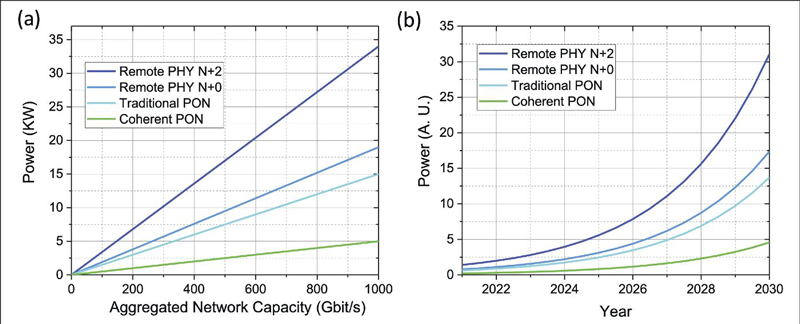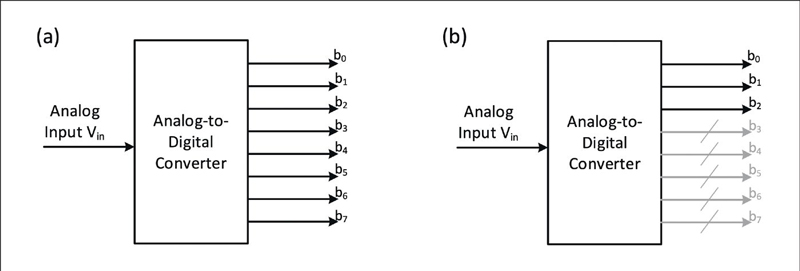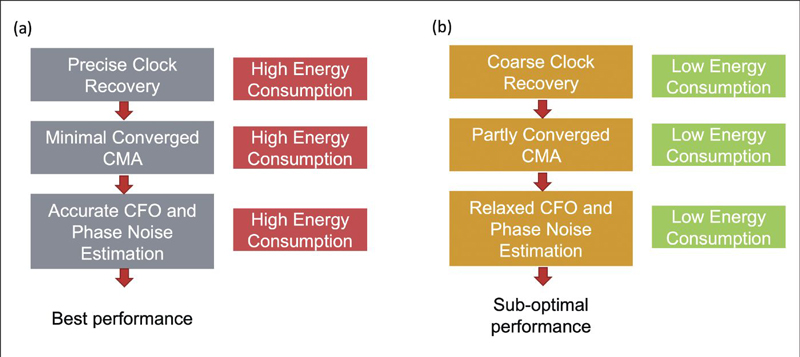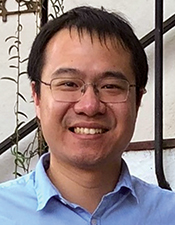Green Optical Communication Architecture and Technology and Their Impact on Future Broadband Access
By Mu Xu, Alberto Campos, and Zhensheng Jia
Today, for communication systems, we tend to emphasize higher speed and lower latency but ignore the importance of energy efficiency. Not only an environmental and social issue, but energy consumption also incurs a great economical concern for cable and data center operators since it contributes a significant part of the network operation expenditures (OPEX). It also provides us a new perspective to understand the network. It is an indicator, using joule/bit instead of bit/second, to measure how healthy the network is. For the cable industry to keep a steady and sustainable growth, improving the network power utilization efficiency (PUE) becomes critical in many aspects. First it reduces network OPEX. It also helps to maintain the long-term capacity growth and new wireless service expansion. On the other hand, it enhances our network energy security and reduces grid dependence especially during outages and under severe weather conditions. In this article, we review green optical communication technologies and demonstrate how they can help to improve energy efficiency and contribute to the long-term energy sustainability of broadband access networks.
Impact of energy consumption in ICT and access networks
In recent years, the make-up of global energy usage has experienced a profound change [1] – [3], as shown in Fig. 1. Among all the categories, the energy consumption from information and communication technology (ICT) grows at a rate of ~7% per year, which is significantly faster compared with the other categories of 2.3% per year on average. Under this trend, the ICT’s percentage of global energy consumption increases from 10% in 2020 to around 20% in 2030. Within the ICT category, 37% of the energy is consumed by communication including mobile, telecom, cable, and satellite networks, 30% is consumed by data centers, and the remainder is consumed by usage and manufacturing of customer devices. It can be observed that the impact of ICT becomes more and more important, and the development of communication and data center networks is a major driver behind this.

Figure 1. Pie chart of energy consumption of ICT.
Optical communication technology plays an important role in ICT. It is a key element of interconnects and switches. It is the foundation in long-haul and metro networks. It also plays a major role in access networks, including hybrid fiber/coax (HFC), mobile xHaul, and fiber to the home (FTTH). Typically, because of the low propagation loss of optical fiber and the passive elements used, optical networks do not heavily rely on amplifiers, thus leading to a much lower energy consumption. However, following the increased capacity and deeper penetration of fiber networks towards home users, the energy usage of optical transceivers is still quickly growing and becomes a factor to consider in the design and cost analysis of systems. Fig. 2(a) and (b) compare recent tendencies of bandwidth density and energy efficiency among optical transceivers packaged

Figure 2. (a) bandwidth density, (b) energy efficiency, and (c) decomposition of energy consumption of optical transceivers in different form factors.
over different generations of form factors [4]. Following the time sequence, these platforms include C form-factor pluggable (CFP), quad small form factor (QSFP), consortium for on-board optics (COBO), and the future-proof co-packaged optics (CPO). Generally, the later version of the pluggable optical transceiver module is featured by a higher degree of integration and more compact size, which enables more transceivers on different wavelengths to be integrated thus leading to a higher aggregated data rate per chipset. For example, in the upcoming CPO 51.2T form factors, CPO transceivers and switch ASIC will share a single organic substrate limited to 90 mm x 90 mm footprint enabling the switching of 64 links of 800G Ethernet with a total data rate of 51.2 Tbit/s. On the other hand, following the bandwidth density growth, the energy efficiency is also improved. Thanks to the recent progress in CMOS fabrication technology from 14 nm to 7 nm and new CPO design, the optical chipsets are brought very close to the processors simplifying the retiming and serializer/de-serializer (SERDES) systems. The reduced transistor size also leads to a lower voltage to remain functional, which also contributes to an improved energy efficiency.
With the progress of design simplification, silicon photonics and semiconductor manufacturing processes, the cost of coherent devices continues to decrease, which may enable coherent optics to replace direct-detection links in mobile fronthaul, aggregation nodes, and access networks. It is anticipated that, with the greatly improved receiver sensitivity and stronger robustness under chromatic dispersion, coherent optics could significantly enhance the transmission distance and number of connected users in next-generation passive optical networks (PONs). Fig. 2(c) shows the decomposition of the energy consumption in a coherent optical transceiver. It can be observed that in coherent systems, quite a lot of energy (~ 50%) is used by digital signal processing (DSP) and digital to analog or analog to digital converters (DAC/ADC), since the high-speed operation of the DSP ASIC and other electrical components is quite power hungry [5], [6]. The second largest part is taken away by coherent transmitters, where the laser, modulator driver, and bias control are major energy consumers. The coherent receiver uses around 15% of the energy, which is mainly consumed by optical local oscillators, balanced photo detectors, and trans-impedance amplifiers. In coherent optics, because of the more complex signal recovery procedures, the DSP part consumes much higher energy than intensity-modulated and direct detection (IM-DD) systems. Coherent optics also requires four data channels to transmit data simultaneously, which also adds to the energy consumption. As a result, for a single transceiver with the same symbol rate, a coherent optical module consumes much higher energy than IM-DD counterparts. However, that may not be the case when using coherent optics in the access network to serve the same number of households.

Figure 3. Comparison of power usage versus (a) aggregated network capacity and (b) time for different options.
Fig. 3 compares the estimated power efficiency of different broadband access technologies in HFC, including remote PHY N+2, remote PHY N+0, traditional PON, and future-proof coherent PON under the same household-passed conditions. The
 Table 1. Estimated power consumption of different network components.
Table 1. Estimated power consumption of different network components.
estimated energy consumptions of the key components are listed in Table 1, which combines the data in Ref. [7] and [8], and hands-on experience. The component includes remote PHY device (RPD), converged cable access platform (CCAP) core, amplifier, and optical line terminal (OLT). The power efficiency is estimated by the overall power usage divided by the network capacity. The change of power usage in time is estimated by the model considering power efficiency and Moore’s Law. From Fig. 3(a), the solution of remote PHY N+2 implicates the lowest power efficiency because a large number of amplifier and RPD nodes adds to the overall power load. Remote PHY N+0 greatly improves the energy efficiency because of reduced density of amplifiers in the network, which enables its performance to approach that of XGS-PON. The energy efficiency of XGS-PON is slightly improved because it completely eliminates the amplifiers. It is worth noting that the 100G coherent PON (CPON) shows a significant superiority in energy efficiency among the four options. The reason comes from the advantage of CPON in capacity and transmission distance, which enables more than 80% reduction in total number of OLTs and also does not need amplifiers in between. Meanwhile, to support the increased number of subscribers and maintain the Moore’s law of capacity expansion, the power usage of the network inevitably keeps growing every year. Fig. 3(c) compares the growing trends of the four options assuming that each option will remain at the same power efficiency in time. It is observed that the growing rate of CPON is still much slower with a better sustainability in energy utilization.
Energy saving in optical transceivers
Even though when PON-based FTTH is deployed, the exponential growth of the network energy consumption will eventually create a heavy burden in operators’ OPEX. Considering cost and environmental impacts, it is also critical to develop technologies to improve the energy efficiency of optical networks. Generally, there are two main approaches to improve the energy efficiency of the network. The first approach is at the device-level, namely, to make the transistors smaller. Smaller transistors require less power for their functioning. This reduces the overall power consumption of the chip. Less power also results in the generation of less heat and thus also alleviates energy used by the cooling system. However, this alone might not lead to a sustainable solution. To date, component production using 5 nm semiconductor manufacturing process has already begun. In the future, achieving 3 nm and 1 nm manufacturing processes will become more and more challenging due to the fundamental physical limitations from quantum effects [9]. Nevertheless, energy efficiency can also be improved by system design and network optimization. Recently, a number of studies have been conducted in this area including using a sleep mode or energy saving mode [10], which can actively reduce the energy usage of transceivers during idle time or when network traffic is low. A sleep mode can be realized by applying simplified coding and DSP in the physical layer or low-power bandwidth allocation in the MAC layer [11].
In coherent optics, the most power-hungry components under high-speed operations are the DAC/ADC and DSP ASIC. Different approaches have been proposed to improve the energy efficiency in this field. To deal with the high energy consumption of DAC/ADC devices, a method to control the resolution of DAC/ADC devices is proposed as shown in Fig. 4. During the regular operation as shown in Fig. 4(a), an ADC is working under full-channel operation with the best conversion resolution it can achieve. However, during the off-peak time or under an energy-saving mode, the ADC at the receiver site can selectively shut down some of the binary output channels thus being on hold with a reduction in energy consumption as shown in Fig. 4(b). On the other hand, a lot of power is used by the DSP ASIC under high-speed operation. As shown in Fig. 5(a), in the traditional coherent signal recovery process, every step is required to be running with the best performance, like highly precise clock recovery, fully converged channel equalization, and highly accurate carrier recovery, where the energy consumption is pretty high. However, as shown in Fig. 5(b), when certain relaxations are allowed for these procedures to operate under sub-optimal performance, the computational complexity and the number of iterations can be greatly reduced, leading to a much lower energy consumption. In addition to the DAC/ADC and DSP domain, many other techniques can be applied in system to improve energy efficiency in the coherent optics, including optical frequency comb [12] and simplified coherent Tx / Rx architecture [13], which deserve to be further studied.
 Figure 4. Adaptive resolution control to reduce energy consumption in analog-to-digital converters.
Figure 4. Adaptive resolution control to reduce energy consumption in analog-to-digital converters.

Figure 5. Switching between high-performance and simplified DSP.
 Figure 6. Operation principle of energy saving system in optical transceivers.
Figure 6. Operation principle of energy saving system in optical transceivers.
By jointly controlling the driver, DSP, DAC/ADC, modulation, and coding systems, an energy-saving mode can be introduced for the network to save energy when needed. The conceptual diagram of the energy-saving system (ESS) in a coherent transceiver is shown in Fig. 6. The system is mainly composed of three functioning blocks. The network energy status monitoring subsystem collects information about energy usage from the outside network elements and internal devices. Based on the information, the processing and analysis block optimizes the system parameters and will instruct the power control and management system to dynamically adjust the driver voltage, DSP parameters, DAC/ADC resolution, and modulation and coding schemes to achieve a good trade-off between energy consumption and performance. Not only limited to coherent optics, the proposed ESS is a general-purpose system which can also be extended for transceivers in IM-DD PON, mobile xHaul, and datacenter interconnects to further improve their energy efficiency.
Conclusion
In this article, the trends of energy usage in ICT and optical networks were reviewed. It is clear that, driven by the continuously growing demand in network speed, capacity and quality of service, ICT in general, and communication and data center networking in particular, will gain a bigger share in future global energy usage. To maintain a sustainable business growth and to efficiently support new service expansion, heavy deployment of optics in current wired and wireless networks is not just scalable but perhaps the only long-term viable power efficiency approach. The impact in future energy consumption for different networking technologies have been compared, and among all of them, coherent PON shows a clear superiority in energy efficiency. Potential technologies for energy saving are demonstrated and a general-purpose ESS embedded in optical transceivers is also introduced.
References
[1] https://www.enerdata.net/publications/executive-briefing/between-10-and-20-electricity-consumption-ict-sector-2030.html
[2] https://www.digitalinformationworld.com/2020/02/the-global-energy-consumption-of-information-technologies-infographic.html
[3] Nicola Jones, “The information factories: data centers are chewing up vast amounts of energy,” Nature, vol. 561, pp. 163-168, Sep. 2018.
[4] E. Timurdogan, Z. Su, R. Shiue, M. J. Byrd, C. V. Poulton, K. Jabon, C. DeRose, B. R. Moss, E. S. Hosseini, I. Duzevik, M. Whitson, R. P. Millman, D. A. Atlas, and M. R. Watts, “400G silicon photonics integrated circuit transceiver chipsets for CPO, OBO, and pluggable modules,” Proc. OFC 2020, paper T3H.2.
[5] T. Kupfer, A. Bisplinghof, T. Duthel, C. Fludger, and S. Langenbach, “Optimizing power consumption of a coherent DSP for metro and data center interconnects,” Proc. OFC 2017, paper Th3G.2.
[6] Yang Yue, Qiang Wang, and Jon Anderson, “Experimental investigation of 400 Gb/s data center interconnect using unamplified high-baud-rate and high-order QAM single-carrier signal,” MDPI Applied Science, vol. 9, no. 2455, pp. 1-9, 2019.
[7] Cisco white paper, “Advantage remote PHY: an analysis of remote PHY vs analogue deep fiber total cost of ownership,” https://www.cisco.com/c/en/us/solutions/service-provider/industry/cable/advantage-remote-phy.html
[8] Todd Loeffelholz, “Fiber deep networks and the lessons learned from the field,” Proc. SCTE 2017 Fall Technical Forum, pp. 1-14.
[9] Jonathan Koomey and Samuel Naffziger, “Moore’s Law might be slowing down, but not energy efficiency,” IEEE Spectrum, https://spectrum.ieee.org/computing/hardware/moores-law-might-be-slowing-down-but-not-energy-efficiency
[10] A. R. Dhaini, P. Ho and G. Shen, “Toward green next-generation passive optical networks,” IEEE Communications Magazine, vol. 49, no. 11, pp. 94-101, 2011.
[11] J. Zhang and N. Ansari, “Toward energy-efficient 1G-EPON and 10G-EPON with sleep-aware MAC control and scheduling,” IEEE Communications Magazine, vol. 49, no. 2, pp. s33-s38, 2011.
[12] H. Zhang, M. Xu, J. Zhang, Z. Jia, L. A. Campos, and C. Knittle, “Highly efficient full-duplex coherent optical system enabled by combined use of optical injection locking and frequency comb,” Journal of Lightwave Technology, vol. 39, no. 5, pp. 1271-1277, 2021.
[13] Y. Zhu, L. Yi, B. Yang, X. Huang, J. S. Wey, Z. Ma, and W. Hu, “Comparative study of cost-effective coherent and direct detection schemes for 100 Gb/s/λ PON,” Journal of Optical Communication and Networking, vol. 12, no. 9, pp. D36-D47, 2020.

Mu Xu,
CableLabs
Mu Xu received a B.S degree in Electronics Engineering from Tianjin University, Tianjin, China, an M.S. degree in Telecommunication Engineering from Shanghai Jiao Tong University, Shanghai, China, and a Ph.D. degree from Georgia Institute of Technology, GA, USA. He is currently a Lead Architect at CableLabs, Department of Core Innovation. Dr. Xu has authored 39 peer reviewed journal articles, 50 conference articles, and holds six granted patents. His research is focused on coherent optical system design, digital signal processing, and fixed wireless converged systems.
Alberto Campos, Fellow, CableLabs, and Zhensheng Jia, Distinguished Technologist, CableLabs, contributed to this article.
shutterstock


